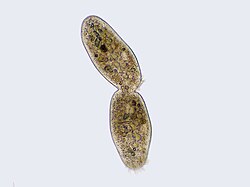
Back انقسام السيتوبلازم Arabic Sitokinez Azerbaijani Цитокинеза Bulgarian Citokineza BS Citoquinesi Catalan Cytokineze Czech Citocinesis Spanish Tsütokinees Estonian سیتوکینز Persian Cytodiérèse French


Cytokinesis (/ˌsaɪtoʊkɪˈniːsɪs/) is the part of the cell division process and part of mitosis during which the cytoplasm of a single eukaryotic cell divides into two daughter cells. Cytoplasmic division begins during or after the late stages of nuclear division in mitosis and meiosis. During cytokinesis the spindle apparatus partitions and transports duplicated chromatids into the cytoplasm of the separating daughter cells. It thereby ensures that chromosome number and complement are maintained from one generation to the next and that, except in special cases, the daughter cells will be functional copies of the parent cell. After the completion of the telophase and cytokinesis, each daughter cell enters the interphase of the cell cycle.
Particular functions demand various deviations from the process of symmetrical cytokinesis; for example in oogenesis in animals the ovum takes almost all the cytoplasm and organelles. This leaves very little for the resulting polar bodies, which in most species die without function, though they do take on various special functions in other species.[1] Another form of mitosis occurs in tissues such as liver and skeletal muscle; it omits cytokinesis, thereby yielding multinucleate cells (see syncytium).
Plant cytokinesis differs from animal cytokinesis, partly because of the rigidity of plant cell walls. Instead of plant cells forming a cleavage furrow such as develops between animal daughter cells, a dividing structure known as the cell plate forms in the cytoplasm and grows into a new, doubled cell wall between plant daughter cells. It divides the cell into two daughter cells.
Cytokinesis largely resembles the prokaryotic process of binary fission, but because of differences between prokaryotic and eukaryotic cell structures and functions, the mechanisms differ. For instance, a bacterial cell has a Circular chromosome (a single chromosome in the form of a closed loop), in contrast to the linear, usually multiple, chromosomes of eukaryote. Accordingly, bacteria construct no mitotic spindle in cell division. Also, duplication of prokaryotic DNA takes place during the actual separation of chromosomes; in mitosis, duplication takes place during the interphase before mitosis begins, though the daughter chromatids don't separate completely before the anaphase.
- ^ Schmerler Samuel, Wessel Gary (January 2011). "Polar Bodies - more a lack of understanding than a lack of respect". Mol Reprod Dev. 78 (1): 3–8. doi:10.1002/mrd.21266. PMC 3164815. PMID 21268179.
© MMXXIII Rich X Search. We shall prevail. All rights reserved. Rich X Search